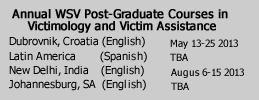

Events and Professional Education

Affiliated Organizations
Basic Statutes of Incorporation | Strategic Plan | WSV Structure | Executive Committee |
Committees and Chairs | Laureates and Presidents | Affiliated Organizations
Mexican Society of Victimology
Phone: 00525 56063852
Fax : 00525 56666781
Email: [email protected]
Coordinator
María Lima
Email:[email protected], [email protected]
Technical cooperation and training
Gabriela Saavedra: [email protected]
Connectivity
Ana Luisa Barrón Rodríguez: [email protected]
Mexican Society of Victimology
Mission
To promote, fortify and reinforce the expansion of rights for victims of crime and abuse of power, to assure that all society respects them and to achieve connectivity with all practitioners in the field.
Specific Objectives
- Strengthen organizations of students of Victimology, professionals, public servants, victims and their families, witnesses, and networks interested and/or working on the topic.
- Promote a strategic database of services for victims’ agencies across Mexico and generate visibility to the government and the civil society on victimological approaches.
- Generate synergy between professors and researchers working on victimology to promote the exchange of information, the expansion of publications and the study of victimologic theories.
- Build strategic links between governmental and nongovernmental organizations related to assistance to victims, including those that work with victims of abuse of power.
- Promote technical cooperation and training for the practitioners of services for victims inside and outside the Criminal Justice System.
- Encourage new models for assistance to victims outside the Criminal Justice System.
- Collect victimological prevention best practices in Mexico, relay them and share them with other states or/and Mexico City.
- Spread victimological guidelines, standards, norms and publications.
- Endorse tactical links to promote participative democracy of victims, to sensitize and generate an agenda in Mexico.
- Promote victimology courses, conferences and forums in universities.
- Engage the community in victim’s issues.
Background
- In 1989, The Mexican Society of Victimology was established as branch of the Mexican Society of Criminology, promoting both victimological theory development and practice.
- In 1980, it promoted the first course in Victimology in the National Institute of Penal Science.
- During that time Muñoz Sanchez, Rodríguez Manzanera, Sabido and Tocavén made the empirical research that became the basis for the creation of victim’s models.
- In 1989, it organized the III National Congress on Victim’s rights in San Luis Potosi México.
- In the same year, the Attorney General of Mexico DF., through María de la Luz Lima as head of sexual crimes prosecution, funded the first services for victims unit in México, (Sexual Crime Unit). Later, this model was used to promote other services in other states.
- The feminist movement worked with María de la Luz in the promotion of a civil organization of women to serve as watchdog to the new Service. (Grupo Plural Pro Victimas A.C.).
- In 1988, Professor Luis Rodríguez Manzanera, president of the Mexican Society of Criminology published the first book on Victimology, used today as a text book in all Latin-American universities.
- In 1993, the organization endorsed the Constitutional Federal Victims Reform.
- In 1995, the International Course for Justice and Victims’ assistance is organized in collaboration with the International Society of Criminology.
- In 2000, the organization promoted the creation of the first two year Masters Degree course in Victimology with the National Institute of Penal Science in Mexico City, the international board was established by members of the Executive Committee of the World Society of Victimology.
- In 2000, the Mexican Society of Victimology was formally established as a twin organization of Mexican Society of Criminology.
- In 2006, the organization decides to advance to a new organizational model with the principles of autonomy, specialty and connectivity in accordance to its new mission.